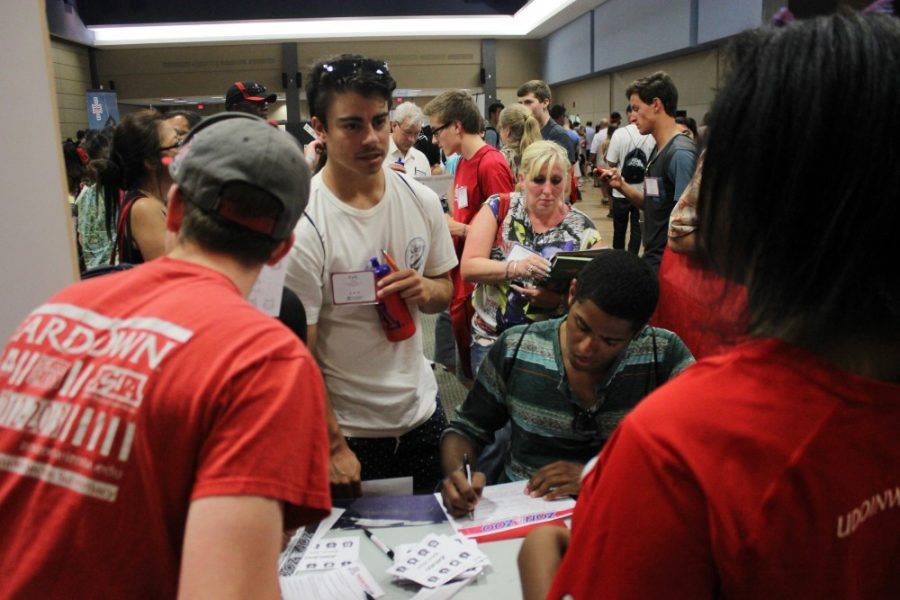UA enrollment reports show tuition hikes are not affecting the rate of new students entering the university. In fact, enrollment is at its peak and is continuing to rise.
Through budget cuts, increasing tuition and a national recession, UA new student enrollment has increased annually since 2006, with the exception of 2013 when new student enrollment fell from 9,365 in 2012 to 8,865.
The Department of University Analytics and Institutional Research released a report last year of the university student headcount, with some statistics dating back to 1976.
The report showed the largest freshman class totaled 8,037 students and the largest new student enrollment totaled 10,122, in 2015. The increase did not go unaccounted for in graduate programs.
Total graduate student enrollment was its largest with 7,864 students for 2015, according to the report. That’s the highest number since 1994.
The UA has not seen a decrease in total student population since 2006. The report tallied 43,088 students at the UA in 2015, the highest it has ever been. That’s up from 42,236 in 2014, according to UA records.
The Arizona Board of Regents passed the tuition plan on April 7 set by UA President Ann Weaver Hart for the coming academic years. This will add to what is considered the highest increase in tuition in Arizona since the Great Recession, according to a study from the Center on Budget and Policy Priorities.
Laura Bracamonte, coordinator of university analytics and institutional research, said the price of school has not deterred future Wildcats from enrolling at the UA. Bracamonte expects an increase in enrollment for the coming year.
“Well, [tuition] hasn’t stopped them yet,” Bracamonte said.
Arizona’s adjustment to inflation was almost three times higher than the national average from 2008 to 2015. The national average was a 29 percent increase compared to Arizona’s 83.6 percent increase. Accounting for inflation, the increase is equivalent to $4,734 in additional tuition per student at an Arizona university, according to the Arizona Republic.
The new tuition plan requires incoming freshmen and current students who are not signed up for the Guaranteed Tuition Program to pay more money next semester. The prices will vary for each student depending on if they are out-of-state or in a graduate program.
The lowest increase will be $299 for continuing resident undergraduates who did not opt in for the tuition guarantee. The largest increase, totaling $2,337 in additional tuition, will fall on incoming nonresident undergraduates.
Andrew Comrie, UA provost and senior vice president for academic affairs, said these groups of students will be eligible to have their tuition guaranteed in their future semesters at UA. He added the program has helped find the right balance at the UA and has served as a recruitment tool.
“It makes an important difference for many families and students planning to attend the UA because they can plan on the cost of tuition and mandatory fees staying flat for their degree,” Comrie said.
The Guaranteed Tuition Program shows UA’s commitment to help students attend the college, according to Kasey Urquidez, vice president for Enrollment Management and Student Affairs Advancement.
“In order to help families and students plan, we instituted the Guaranteed Tuition Program a few years ago and added a guarantee to mandatory fees as well,” Urquidez wrote. “The predictability and transparency is helpful in the planning process.”
Giovanni Cherico, a junior studying agribusiness economics and management and a military serviceman with government-paid tuition, rarely uses campus facilities but realizes student fees come in handy when he does use campus resources.
“I do use the Rec Center [sic] once in a while,” Cherico said. “I don’t rent anything. I use the computers once in a while. … I guess I utilize the facilities that are associated with those fees.”
For Robert Marshall, a music graduate student, student fees have proven useful, especially when it comes to using the library for school work.
“The library fee and technology fee have been really helpful,” Marshall said. “I check out a lot of equipment for recording from the libraries.”
Because of Hart’s new tuition plan, incoming undergraduates and all graduate students will see an increase in next year’s tuition costs. For Associated Students of the University of Arizona President Manny Felix, this could change the future of the UA student population.
“If tuition increases in the next few years, then I think [enrollment] will be affected.”
But even with a sharp increase, Felix said he thinks student fees are for the students’ benefit at the UA.
“If you want to know where your tuition is going,” Felix said, “Go to class, go to the gym, join a club.”
Follow the Daily Wildcat on Twitter









